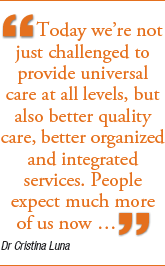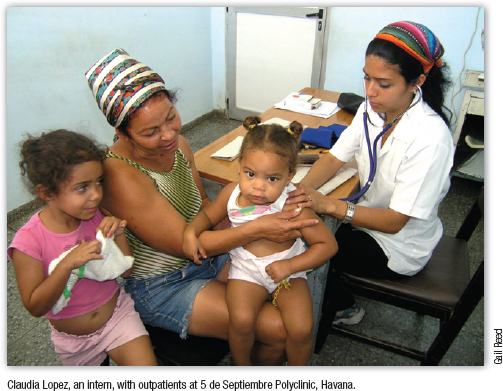NEWS
Cuba's primary health care revolution: 30 years on
With the community-based polyclinic as its centrepiece, the country's primary health care system has produced enviable results as it continues to adapt to new challenges. Gail Reed reports from Havana.
"We fought for the Declaration of Alma-Ata before it was official," says Dr Cristina Luna, "and its message has guided and challenged us ever since." At 43, Luna is Cuba's national director of ambulatory care, and on her shoulders rests the country's entire primary health care system, by many standards one of the world's most effective and unique.
Cuban health authorities give large credit for the country's impressive health indicators to the preventive, primary-care emphasis pursued for the last four decades. These indicators which are close or equal to those in developed countries speak for themselves. For example, in 2004, there were seven deaths for every 100 000 children aged less than five years a decrease from 46 such deaths 40 years earlier, according to WHO. Meanwhile Cubans have one of the world's highest life expectancies of 77 years.
The centrepiece of this system is the community-based polyclinic, each of the 498 nationwide serving a catchment area of between 30 000 and 60 000 people. The polyclinics act also as the organizational hub for 20 to 40 neighbourhood-based family doctor-and-nurse offices, and as accredited research and teaching centres for medical, nursing and allied health sciences students. "These are the backbone of Cuba's health system," Luna says.
"But today we're not just challenged to provide universal care at all levels, but also better quality care, better organized and integrated services. People expect much more of us now than when we were introducing the Rural Medical Service."
The period Luna refers to was the early 1960s, when Cuban government policy first focused on reaching people mainly in rural areas with little or no access to medical services following the Cuban revolution during the 1950s. The government started by enlisting 750 physicians and medical students for a period of their professional lives to work in the mountains and coastal communities. The aim of el servicio médico rural or the Rural Medical Service, according to its developers, was to provide "disease prevention and to revitalize health services for those most in need, whether because they are poor, in precarious health or live far from urban centres".

Multi-specialty polyclinics were established across Cuba in the 1970s, before the 1978 Declaration of Alma-Ata, and these were transformed with the addition of the family doctor-and-nurse programme in the mid-1980s, enhancing the health system's ability to deliver on prevention and community-health analysis, as well as clinical services. By the 1990s, the programme had posted family doctors and nurses throughout the country, and was attending to more than 95% of the population. "We were conscious that prevention had to be a cornerstone of our system," Luna says, "and that people had to be understood in all their dimensions: biological, psychological and social [and] as individuals, within families, and within their communities."
Today, Cuba has about 33 000 family physicians. Specialization in family medicine is a requirement for more than 97% of medical graduates, who spend one internship year and two residency years in training after they receive their degrees. Later, they can apply for a residency in a second specialty. As a result, the ranks in these second specialties are being swelled by physicians who started their careers in family medicine.
In 2008, Cuba's primary health care is again being transformed. Since 2002, 241 polyclinics have undergone extensive renovation, a process that continues today. The aim is to add services previously available only in hospitals. Now, the average polyclinic offers 22 services, including rehabilitation, X-ray, ultrasound, optometry, endoscopy, thrombolysis, emergency services, traumatology, clinical laboratory, family planning, emergency dentistry, maternalchild care, immunization, and diabetic and elderly care. Various other specialties including dermatology, psychiatry and cardiology are available too, in addition to family and internal medicine, paediatrics, and obstetrics and gynaecology.

Five-year-old Daysel Rojas has been attending the 5 de Septiembre Polyclinic in Havana for physiotherapy since he was four months' old. "The rehabilitation facilities are much broader now," says his mother, Dania Esquijarosa. "It makes a big difference to us, since we come every day. We don't have to wait, and they take the children first."
Dr Rebeca Mendoza, the director of the polyclinic, says 800 to 1000 patients a day use the services.

Another change has come with the abolition of a rather uniform type of polyclinic. "We once thought that each polyclinic should look the same," says Luna. "But a more rational and effective use of our resources says that beyond the polyclinics' basic set of services, additional ones should respond to the specific health picture of the community served. So, if there are many smokers, we should have counselling a few nights a week, not just one. If we have many allergies in the area, then the polyclinic should have allergy testing services, and so on."


This notion, in turn, relies on active population screening for a clear community health diagnosis. "We know from the family doctor-and-nurse surveys that we have 22.5% of people in our health area with high blood pressure," says Mendoza. "But we also know from national samplings that there are more who remain undiagnosed. Active screening allows us to take a particular condition, like hypertension, and look for the hidden prevalence."

The roles of the polyclinic and the family doctor-and-nurse offices are also changing. "Since 2007, the polyclinics are expected to play a leading role [in capacity building and quality control] among all health-related institutions in their communities," says Luna. "We bring the directors of the pharmacies, the elderly homes, the maternity homes and others into our team," adds Mendoza, "and we have also begun offering further training to the Federation of Cuban Women's health promoters, professionalizing their work in the community."
About half the family doctor-and-nurse offices are still headed by physicians; the other half by nurses whose work is guided by the family physician in the area. There are now about 2500 patients per physician-headed office at the primary care level, buttressed by these nurses who "have a greater role to play," says Luna. The new formula responds, in part, to the need to re-organize the system, with more than 20 000 Cuban physicians living abroad, mostly in Africa and Latin America. Training of new family physicians has also been put on the fast track: "We are now training some 42% more family doctors to make sure we have enough to meet all our commitments," says Luna.
What is left to address? Mendoza says: "We have to pay more attention to patient satisfaction. Some of the staff don't like to hear criticism. But I tell them, 'the day we think we're doing everything right is the day we've abandoned our patients, and also abandoned our commitment to the principles of Alma-Ata'." 
